Finding Ko-Ko
By Ray Pointer
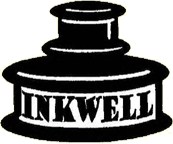 My formative years introduced me to the old theatricals that were first sold to television in the 1950s. These cartoons not only captured my attention due to the fascinating animation, but also instilled an interest in drawing that stayed with me the rest of my life. The first of these vintage series I saw was Out of The Inkwell. Although I didn’t know who the distinguished gentleman with the Austrian style moustache was at the time, the clever interaction with the live action artist and the black-suited clown with the pointed hat hooked me immediately. Although the sight of over-turned ink bottles and spilled ink shown in these films frightened me, I still continued to appreciate them, but with a cautious aside view.My search for Ko-Ko began just as I entered Cass Technical High School, where I was enrolled in the Commercial Art program. I spent many hours hand lettering in pen and ink — this being in the days before it became popularly known as “calligraphy”. I came to hate it because by being left-handed, I had to lay everything out in pencil first, then work backward, bottom to top to avoid smearing the ink. This took twice as long to complete assignments compared to right-handers. But the other reason I hated it was that the India ink smelled like rotten eggs.
My formative years introduced me to the old theatricals that were first sold to television in the 1950s. These cartoons not only captured my attention due to the fascinating animation, but also instilled an interest in drawing that stayed with me the rest of my life. The first of these vintage series I saw was Out of The Inkwell. Although I didn’t know who the distinguished gentleman with the Austrian style moustache was at the time, the clever interaction with the live action artist and the black-suited clown with the pointed hat hooked me immediately. Although the sight of over-turned ink bottles and spilled ink shown in these films frightened me, I still continued to appreciate them, but with a cautious aside view.My search for Ko-Ko began just as I entered Cass Technical High School, where I was enrolled in the Commercial Art program. I spent many hours hand lettering in pen and ink — this being in the days before it became popularly known as “calligraphy”. I came to hate it because by being left-handed, I had to lay everything out in pencil first, then work backward, bottom to top to avoid smearing the ink. This took twice as long to complete assignments compared to right-handers. But the other reason I hated it was that the India ink smelled like rotten eggs.
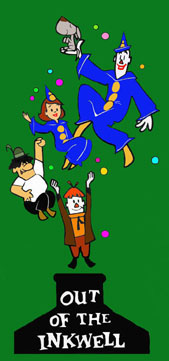
I interviewed for my first job in the animation industry at The Jam Handy Organization the summer of 1967. The department manager, Bob Kennedy told me the history of the company, including the influence of Max Fleischer there in the 1940s, with references to Fleischer’s landmark, Out of The Inkwell. All impressions of splashing, stinking ink aside, the interview progressed to the camera room, where I projected the sample animated cartoons I had brought along. They were finished in full color with sound on tape that worked in synchronization with the projector. Within a few minutes, I had an audience of the entire department standing at the back of the room, all laughing, cheering, and applauding at what they saw. As the lights came on, I was introduced to a short elderly gentleman, Max Fleischer — the Inkwell Man! Max had apparently stopped in to visit old friends — what timing! Imagine the very source of my interest saw my first efforts, and recommended me for my first job! The

impression of those twenty minutes has stayed with me all my life, and while I worked there, I started gathering anecdotes about Max Fleischer that had never been published before, realizing that this was a fantastic subject for a documentary.
It was now 1970, and I was a freshman in the Film and Television Production Program at Wayne State University in Detroit. After my schedule of classes, I went to the main Detroit Public Library and searched through the copyright records for a list of Out of The Inkwell titles. By all accounts, there were about 65 films made during the pre-Paramount period 1919 to 1927. The next step was to find prints.
The Search Begins
The Museum of Modern Art in New York led me to the Willoughby-Peerless Camera Stores in New York, which once carried
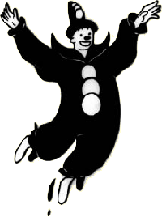
16mm prints of Out of The Inkwell, but their supplier had gone out of business with no forwarding address. Then I contacted the Bray Studios and discovered that they did have a number of their old cartoons available in 16mm, including some 10 Out of The Inkwell films made between 1919 and 1921. Naturally, I wanted to buy them all. I ordered two, The Clown’s Pup (1919) and Automobile Ride (1921). I waited about two months, and then received a polite letter explaining that there were problems with these old negatives. I accepted prints of The Chinaman and The Tantalizing Fly as substitutes. I wanted to buy more, but the negatives already were deteriorating. At least, this was a start.
The Bray Clown
Next I combed through the film rental catalogs, and discovered a number of Ko-Ko titles in the Audio Cinema library in Chicago. These were the 1950 Stuart Productions television releases with music tracks added by Winston Sharples. Over successive weekends, I rented these reels just to see the cartoons and continue my research. I soon discovered certain 16mm libraries that sold prints mostly from the 16mm Kodascope versions made for home exhibition in the 1930s. Having viewed these few films from 1919 to 1925, I made a discovery. There were three different clowns!The mistaken idea has been that the character was always Ko-Ko The Clown. But in the beginning, the clown was known as nothing more than “The Fleischer Clown” or just “The Clown”. He was a literal tracing off live action that tended to be blocky with a small head, and was Fleischer’s first character from 1919 to 1921.
The Inkwell Clown
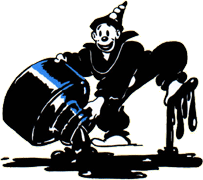
The second clown evolved during the beginning of the Inkwell Studio, and is thinner with a slightly larger head and larger mouth. There is more use of animation, and the techniques start to advance with the animation composited more successfully with live action footage. There is no reference to the name Ko-Ko up to this time, and the films do not refer to a name for the clown in the title cards.
The third clown was the result of a redesign by Dick Huemer in 1923. It was Huemer who named
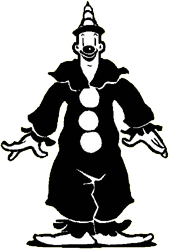
the clown Ko-Ko, and with his previous experience animating Mutt and Jeff, he eventually moved the Fleischers away from relying on the Rotoscope, and the Inbetweening production process was developed — enabling the Fleischers to increase their production output, and maintain the visual stylization of Huemer’s work.
The Quest to Rescue OUT OF THE INKWELL
The print quality of the Bray titles was rather good considering their age and negative conditions. Although I could appreciate the musical background on The Tantalizing Fly, The Chinaman had an unimaginative narration seemingly adlibbed by Alan Swift, with the dialog titles removed for TV release. This caused the action to jump unnaturally, ruining the acting and confusing the storyline. As an experiment, I used one of the soundtracks I’d taped from the Stuart releases, and tried it with The Chinaman. It was like magic. The music fit all the right accents and mood changes as if it had been originally scored for the film.
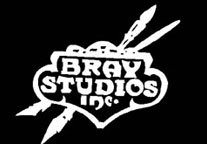
The Kodascope dupes contained printing flaws that I wanted to eliminate to make them more enjoyable. Some were splicy due to lost frames or bad lab handling. Some prints had patched in footage causing unnecessary repeats, and in some cases, there were only four frames of some shots, flash frames and exposure shifts. Some main titles were too short to read, or non-existent. Seeing all this, I would wish that these ugly distractions could also be eliminated, and it seemed to me that with a little imagination, these films could be fixed and presented in a form far superior than their present state. As these films continued to be shown in poor form at retrospectives and Film history classes, the public’s impression was tainted; giving the impression that this was what the films always looked like. But considering their place in film history, I felt strongly that Out of The Inkwell deserved to be treated better, and Max Fleischer’s landmark deserved to be represented in the best possible light.
The Emergence of Home Video
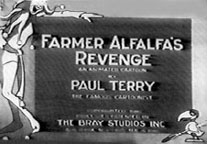
As the iron oxide dust settled from the Betamax vs. VHS battle in the 1980s, obscure Public Domain material came forth from small distribution companies with access to abandoned film chain equipment and private film collections. In the case of old cartoons and their limited, specialized market, there did not seem to be much effort to transfer the films with care, nor was there a judicious selection of material. As a result, many of these compilations of old theatrical cartoons were transferred from poor prints, or sometimes used acceptable prints that were transferred badly without using the proper technical specifications or duplication methods. The result was poorly reproduced, poorly engineered tapes made to make a quick buck, while buyers had to strain to view their purchase, stuck with something less that it should have been, produced under the excuse that the films were old.
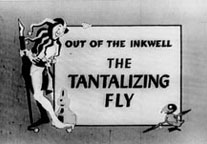
My curiosity was stirred further when I saw the offerings in the Whole Toon Catalog when it premiered in the early 1990s. This catalog would carry disclaimers such as quality “poor” or “very poor”, and I would wonder, “Then why offer it if it is poor?” One day, Mark Langer called me to clarify a detail for his research at Carlton University in Ottawa. During the conversation he asked me if I had ever seen The Chinaman. He said that it was rare, or seemed not to exist. This made me realize that I was sitting on a potential gold mine with my personal prints. As a test, I put together a program called BEFORE WALT, which focused on many of the cartoons being produced when Disney was just beginning. I included three examples of Out of The Inkwell, which demonstrated concepts and story elements that Disney repeated in Alice Chops The Suey, which even starts out using Max Fleischer’s signature of opening the ink bottle.
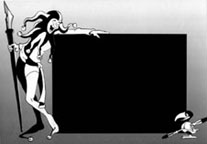
Unlike all the other cartoon packagers, I constructed a program reminiscent of the old Disneyland TV shows that would use a theme to use cartoon segments of related subject matter. Sight unseen, The Whole Toon Catalog ordered 10 copies. It was entered into their listings, and I followed with Alice in Cartoonland. But it was Max Fleischer’s Famous Out of The Inkwell that really took off, being my biggest seller around the world, earning the Gold Entertainment Award at the Houston International Film and Video Festival in 2000. It spawned three additional volumes released in December 2002, and also won the Gold Award again as a video restoration series in 2003. But the process was not automatic.
Working on the small budgets I have, it was impractical and virtually impossible to do all the optical and re-editing work on film. There are fewer and fewer labs left who can do this, and even fewer people who know how to handle film. So videotape and electronics seemed the answer to my restoration problems. First, I supervised the transfer of all the prints on a Rank-Cintel telecine, sometimes physically re-timing the exposures on each scene cut. This gave us sharp transfers with the proper gamma, or contrast range that would hold up in duplication. We were able to transfer some live action footage at, or near the original projection speed. This proved to be worth the effort, since the slowing of the action by 33% revealed a better quality of acting, giving more meaning to what was on the screen. The animation, however seemed to work better at 24fps, so in some cases I had two transfers to cut between to obtain the best possible action.
The next problem was to figure out what the removed dialog cards might have said. In the case to two of the Bray releases, I had help. The Tantalizing Fly still had the dialog card intact, and I was able to use it as the template for all the others that I created later. In the case of The Chinaman, I was loaned an 8mm Keystone digest version that concluded that much of the dialog being spoken on the soundtrack matched the title cards on the 8mm print. For the rest I was on my own.
After restructuring and re-editing, I started to see a more cohesive story structure that was marred before with poorly paced action and bad, choppy editing made worse when these films were butchered and sold to television 50 years ago. This restructuring also revealed a number of details about the development and personality of the clown. Many histories imply that the clown had no personality, when in fact; the format and basic personality were evident from the very beginning. The clown is vain about his costume, he is jealous about his space on the paper, and he takes on motivated revenge towards some mean action perpetuated by Max.
Hearing of my restoration efforts, FilmVideo Releasing Corporation offered the Stuart TV releases to my company, Inkwell Images. Now having archival materials, I was able to work with the Shaples music tracks and build my own scores. The music was magical, hitting all the right accents and mood changes as if it was originally intended for Out of The Inkwell. There was very little altering of picture needed to fit the visual rhythm. So in this case, the music was put to better use than it was in the forgotten adventures of Molly Moo Cow and The Toonerville Trolley.
Although these were silent films, it was apparent that some actions and gags were motivated by sound. For instance, in The Chinaman, the clown grabs the Chinese man and pulls him apart until he bursts like a balloon, causing the kooky artist drawing Max’s portrait to turn around. This cried out for a sound effect. Anyone familiar with the Fleischer cartoons is aware of the aural quality of their soundtracks. There were distinctive acoustical sound effects that were used that are forever identified with these films. So it is only logical that to maintain an audio consistency, the same, or similar types of sound effects must be used to maintain that atmosphere. Although it tends to be a long and tedious process, laying in each effect, the final result is worth the effort; making these silent animation classics enjoyable once again for modern audiences.
Max Fleischer’s Famous Out of The Inkwell is much more than a footnote in books or a novelty on derivative Internet Websites. It is a magical, innovative, and highly successful film series — important enough to influence Walt Disney and many others around the world. Fortunately, these treasures of Animation history have been rescued so that they can be seen as they were meant to be — on the screen. Looking back at it all, it seems that I was destined to save Out of The Inkwell. To call it an adventure is an understatement. I’VE LIVED IT!

See our DVD Out of the Inkwell or my book The Art and Inventions of Max Fleischer: American Animation Pioneer for more about the history of animation.
